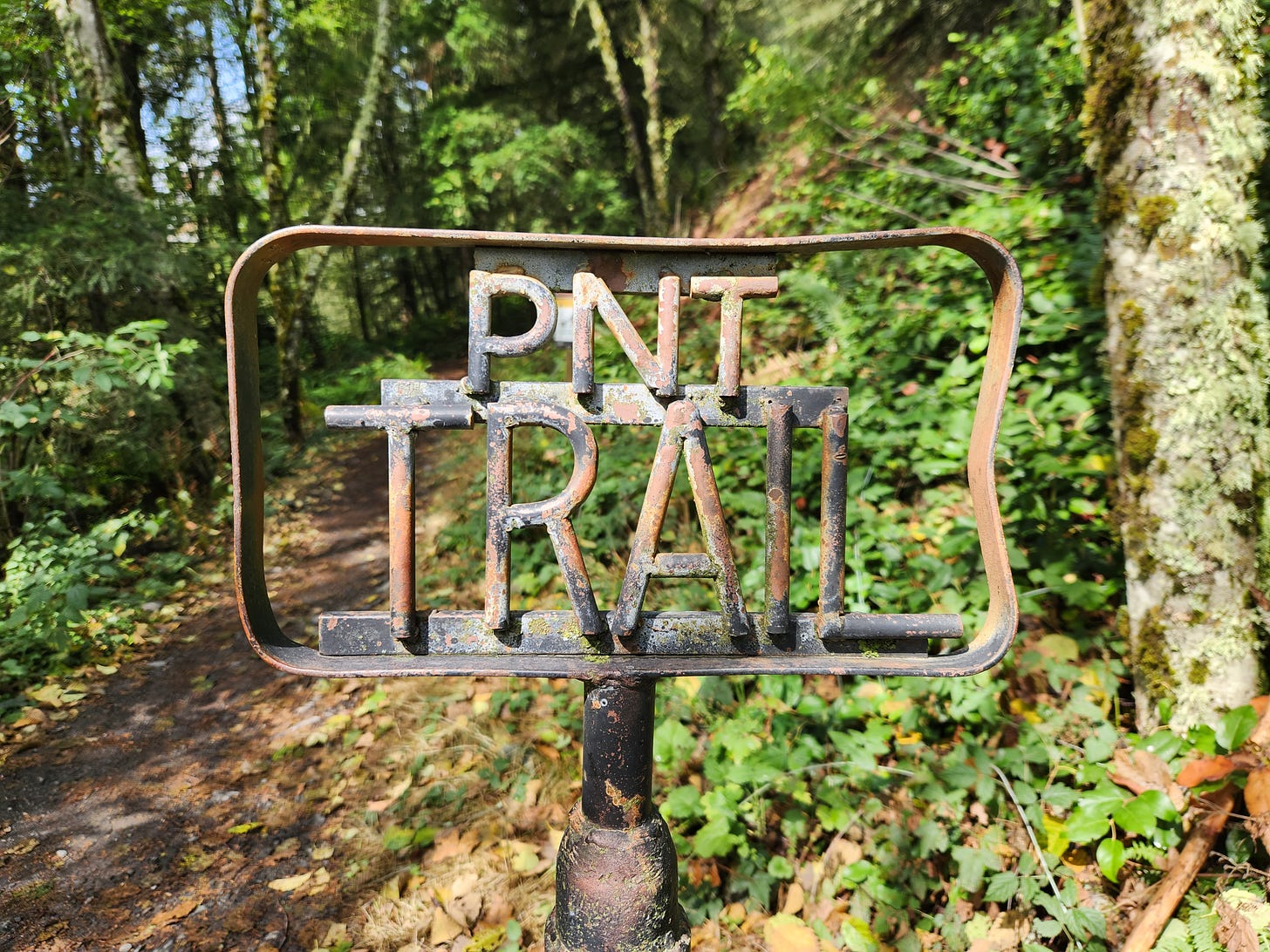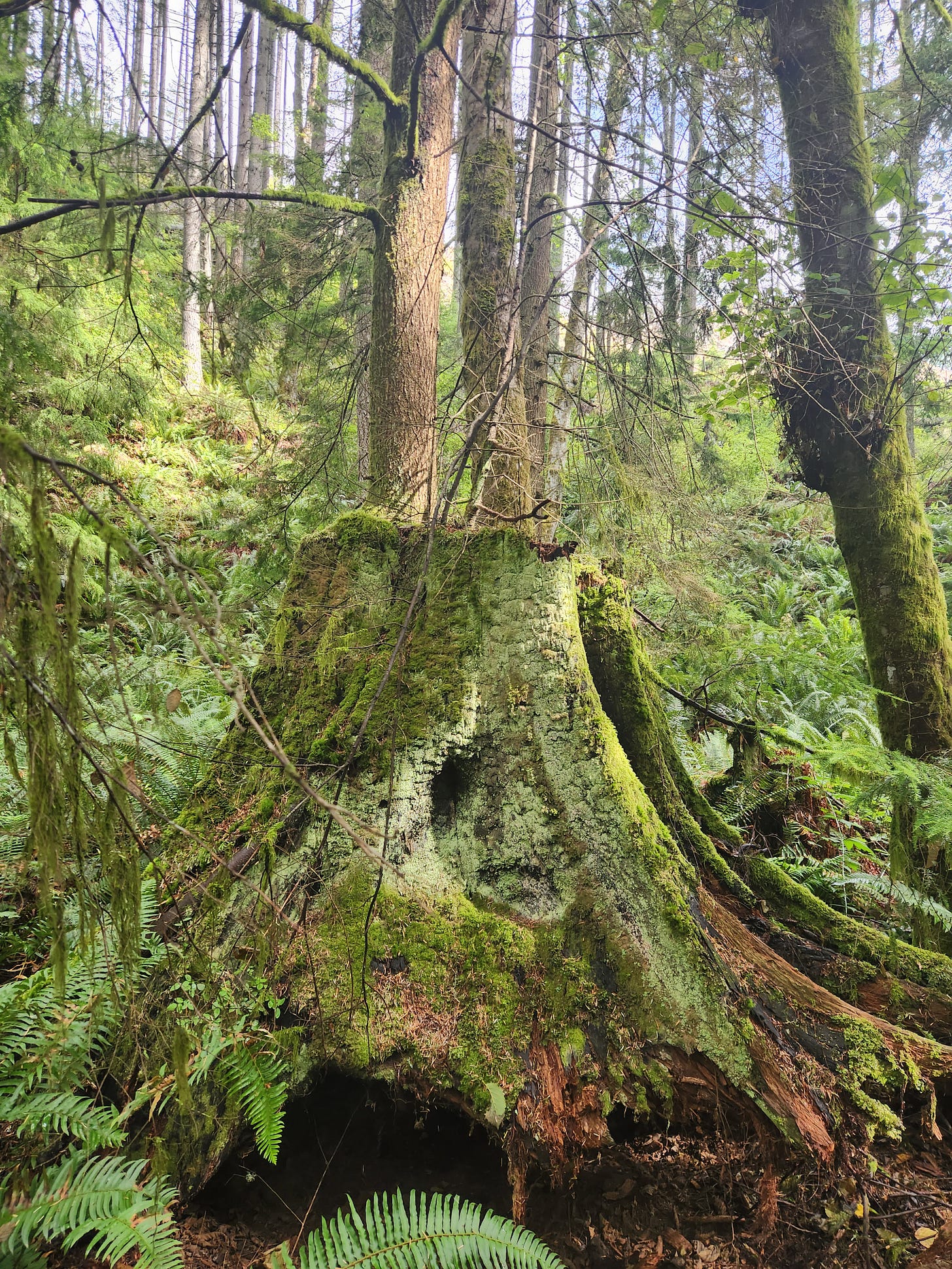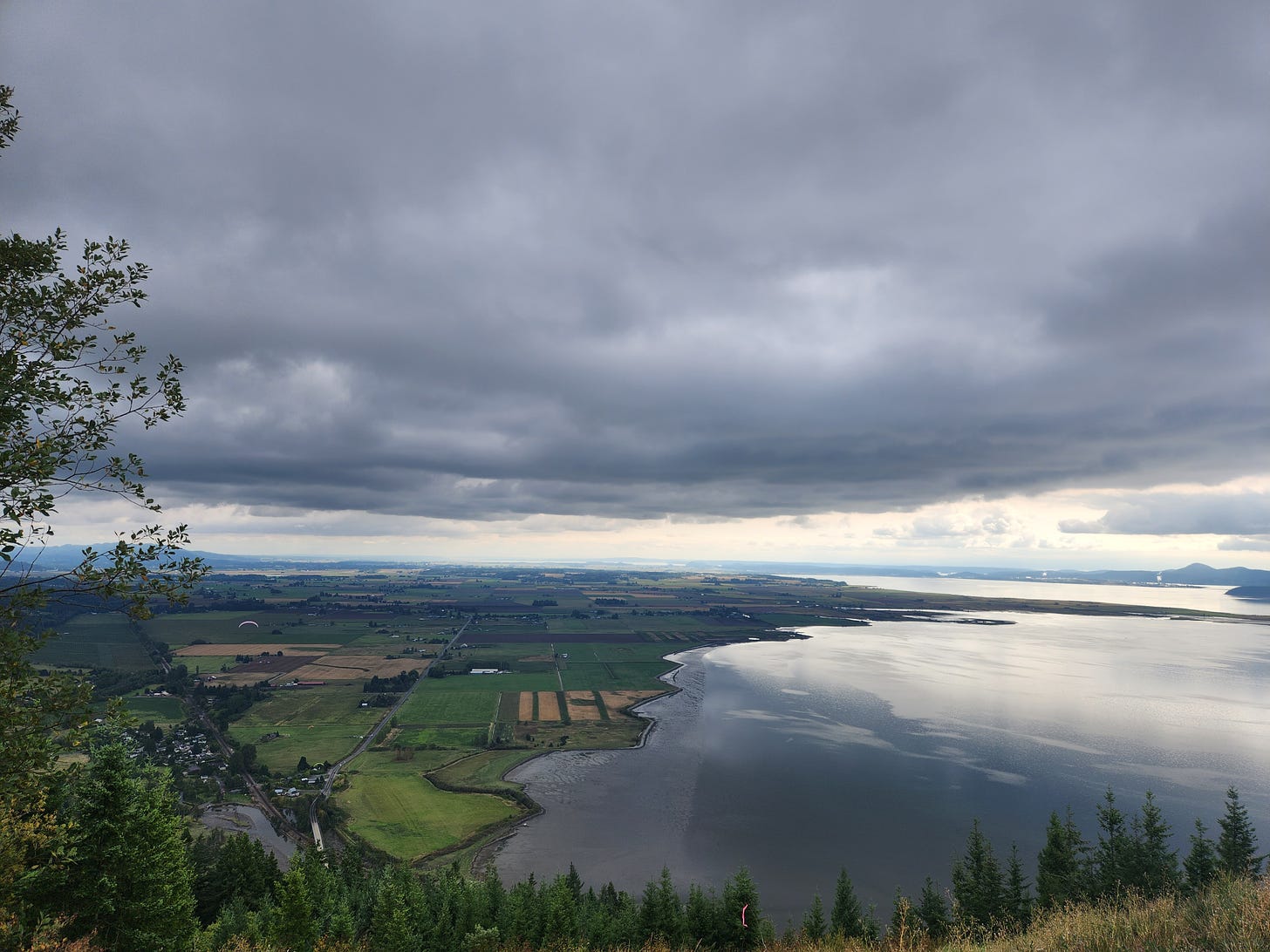After last week’s lesson on the creation of a system of nationally-designated long-distance trails for The Classroom, I figured that for The Field Trip I’d better walk on one. So after lunch on Labor Day, I headed toward Blanchard Mountain to hike a small section of the Pacific Northwest National Scenic Trail that reached Oyster Dome. Read on!

The Blanchard Forest
I’ve hiked to Oyster Dome once before; in fact, it was my first hike in the region after I moved here. The spot is popular, being near to Bellingham and Mount Vernon and only 5-6 miles roundtrip. When I arrived, the parking lot was full and both sides of road leading to it were lined with vehicles. I knew I took a risk heading out on Labor Day, but I thought, “Maybe the afternoon of the third day of a three-day weekend might be OK.” This is precisely when the shoulder season begins, right?
Besides, I remembered that the views from the top would captivate me.
Oyster Dome is within the Blanchard State Forest managed by Washington State’s Department of Natural Resources. State lands traditionally–and by statute–are required to maximize public benefit. For a century and more, that was interpreted to mean log the lands and distribute the receipts to local governments, especially schools. After two decades of activism and creative problem solving, conservationists got the state Supreme Court to acknowledge that “public benefit” includes measures beyond simply economics and ought to include habitat, water quality, and the like. A core area of Blanchard Mountain will now remain unlogged. The PNT cuts through that area.
A trace of dampness had settled on leaves and the trailbed, a relief after months without rain. On occasion as I walked among the even-aged stand of trees and abundant ferns, I moved through faint clouds, offering a slightly eerie ambience. The first part of the trail skirts quite close to a recently logged area, the light from the trees’ absence is noticeable. (The recreation core remains intact, but the forest more broadly still gets cut.) The forest bears other signs of logging in lingering cables and notches in stumps. Also, it shows signs of fire and rain–burned wood and moss and fungi.

I enjoyed observing the forest, but on this busy trail–on Labor Day–the people drew more attention. They ranged from eight to 80. I heard four languages spoken. I caught snippets of conversation that touched on earthquakes, rental properties, hiking gear, dogs, and an essay to write (that wasn’t me talking to myself, I promise!). Few people walked alone; many were in large family or friend groups. I thought much of this belied the myth of hiking being about solitude. At least here, the trail welcomed all kinds in abundance.
Oyster Dome
A good walk among the trees is sufficient, but Oyster Dome is the draw. Rather, the view from Oyster Dome.
At the end of the trail, or one section of it, a rock outcropping allows views over the San Juan Islands in the distance and other islands closer (Lummi, Guemes, Sinclair, etc.) and where Bellingham Bay mingles with Samish Bay that presses toward Padilla Bay. Tankers rest in the water, reminding you of the refineries at March Point that you can see if you look southwest. Trees are everywhere, and you can see small recent cuts and evidence of much larger older cuts.
In other words, from Oyster Dome, you have a panorama that encompasses past and future economies and ecologies. In this vista, the range is inescapable.

On my previous jaunt to Oyster Dome, I joined a friend. We were there in June on a weekday and the rocks were covered with hikers. Finding a spot to sit was easy enough, but there was no way to enjoy a private conversation. On Labor Day, surprisingly, I arrived and only two couples were nearby. They left and for just a moment, I was left with only my thoughts, before a family and then a pack of friends arrived. I took a drink and headed down, grateful for the quiet break and the reminders of the complicated, beautiful place where I live.
I turned my mind to the PNT as I descended. Soon enough, as if I conjured them, I caught two hikers who were on the trail. I recognized them as through-hikers because they were the only people I’d seen all day lugging more than a day pack. This pair, probably in their 60s, came from the Boise and Cincinnati areas and had put in seven weeks already. Three more to go, they told me. They thought they were the oldest through-hikers this year, noting that most through-hikers seemed to take on such an endeavor before their first “real” job or after they were done working. They enjoyed meeting people along the way, but they noted the PNT was in pretty rough shape in various spots. Although they recognized that priorities and budgets are hard to align, they hoped that the Forest Service might improve spots of the trail. Fires forced them to re-route and miss the Pasayten Wilderness and the North Cascades National Park, which was disappointing. But I sensed from my conversation that they were satisfied with their experience walking long miles day after day.
It is a satisfying way to spend time.
Trailhead Again
I popped out of the woods where I began. The trailhead I used at the Samish Overlook is popular with paragliders. These brave/foolish people ride the winds coming from the water and hitting the block of mountains here. It looks exhilarating. And the setting, where the sea meets the mountain meets the farmland, makes it astonishing. The parking lot, amid the trucks and Teslas and Sprinter vans, now had some empty spots. The pickup I noticed when I got there remained with a bumper sticker: Trees Are The Answer. I added in my head, “to so many questions.”

Final Words
Longtime readers of Taking Bearings may remember one newsletter that touched on Blanchard Mountain before. Go to the Archives to revisit this place from a different perspective.
Late last week, a story I wrote about local voluntary conservation was posted here.
And hot off the presses today, my latest reported article.
As always, you can find my books, and books where some of my work is included, at my Bookshop affiliate page (where, if you order, I get a small benefit).
Taking Bearings Next Week
Look for what I hope to be monthly interviews with others who work with place, history, or writing. This will be a new feature for paid subscribers and the first one should be available next week. You can upgrade so you don’t miss any!
Next week, I am supposed to return to The Library, which means I better get to reading something, so I can report back. Stay tuned!



Thanks for this article. I didn’t even know about this trail system, and have lived here forever.
Fun to read about a lovely location. I was up there last year when the clouds had settled below and I felt like I had returned to the last Ice Age, when the Puget lobe pushed down the Sound.